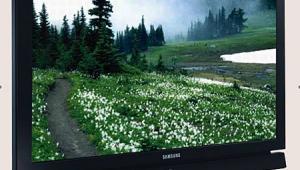Face Off at the HDTV Corral What Do You Think? part 2
My clear favorite in this bunch was the Sony. It’s also the most expensive—does that make me high maintenance? It had the best balance of the qualities I look for in a display. Its color was subjectively my favorite with HD content, well balanced and not fatiguing. The Sony’s black level was absolutely astounding. It was the display I kept coming back to when we demoed the dark belowdecks scene of Master and Commander. It just showed more detail than the others.
The BRAVIA’s black level stood out above all the others. When there was no video signal, its screen was notably blacker than the rest. Likewise, its whites were exceptional. In the sampled scene from Madagascar, the animals’ eyeballs on a black background almost seemed to float in midair in the darkened room.
 Michael J. Nelson
Michael J. Nelson
There is a certain anxiety that comes with taking part in a Face Off such as this. You ask yourself, “Am I up to the task? Will I know what to look for? Will I catch the subtle flaws? Will the invisible Pygmies con-
tinue to follow me and steal my socks?” (Some of my anxieties are specific to the Face Off, while others are more general and constant.) To be sure, this was a very tough challenge.
On relatively bright high-def clips, all these sets looked fantastic. There were minor color oddities, but no one came out looking like an Oompa Loompa. (Well, on the way to the lab, I saw a few guys dressed as Oompa Loompas, but that’s a common sight in Burbank.) The differences in these sets really became noticeable with black level, shadow detail, and viewing angle.
The Pioneer looked great on pretty much everything. I want one. One of my TVs is a well-calibrated rear-projection CRT (no, I don’t still heat my house with coal, thank you very much), so I’m very well acquainted with deep blacks. The Pioneer satisfied me and then some, thanks to its fantastic detail.
The most striking thing was the difference in technologies. I could live with the LCD sets (which I rated the lowest) if I could install a device that locked my head at an angle directly in front of them. Off axis, these things frankly got a little weird. Color shifted, light levels flattened out, shadow detail decreased, children cried, dogs started barking, horses ate each other. If you live alone and never move your body, then these are the sets for you. (Or I suppose your family could take turns watching the same movie.)
Both plasmas far exceeded the LCDs in this regard. Although the Panasonic suffered some flaws, high black levels, problems deinterlacing, and imperfect color, it still did great on detail. I felt the contrast was high enough that I could live with it despite the high black levels. But again, the KURO so easily won that if it were my 5,000 bucks, I wouldn’t hesitate to spend it on that one. But if you’re not as picky and want to save $2,500, I think you could be happy with the Panasonic.
The Pioneer looked great on pretty much everything. I want one. One of my TVs is a well-calibrated rear-pro CRT (no, I don’t still heat my house with coal, thank you very much), so I’m very well acquainted with deep blacks. The Pioneer satisfied me and then some, thanks to its fantastic detail.
 Scott Wilkinson
Scott Wilkinson
This Face Off provided a wonderful opportunity to evaluate four top-tier flat panels side by side, and the results surprised me in some ways. Perhaps most surprising was the fact that I didn’t rate the display with the lowest price (the Panasonic TH-50PZ800U plasma) at the bottom of the pack. That distinction went to the Samsung LN55A950 LED-backlit LCD. Not that it was bad by any means, but in direct comparison with the others, its shadow detail was the worst, and its black level was noticeably higher than the Sony LCD and Pioneer plasma, even with local dimming.
I was not surprised to learn that I had rated the Pioneer Elite PRO-111FD plasma at the top of the heap. Its black level was not quite as low as the Sony KDL-55XBR8, the other LED-backlit LCD in the group, which went to literally zero in blackouts between scenes. But the Pioneer’s black level was second lowest. And in every other way, its picture looked the best, with natural colors and excellent shadow detail.
Ranking the Sony and Panasonic in the second and third spots was more problematic—each had strengths and weaknesses that made it a toss-up for me in terms of performance. As I mentioned, the Sony’s black level was clearly the lowest, but its color had a decidedly greenish cast to it compared with the other three, even though its measurements were right on the money. (I suspect this would not be so obvious when viewed in isolation.) Also, its poor off-axis performance clearly identified it as an LCD, although it wasn’t as bad as the Samsung in this regard.
As for the Panasonic, its black level was the highest of the bunch, but surprisingly, this wasn’t that apparent on many of the clips we watched. The color was much more in line with the Pioneer and Samsung, although skintones were slightly rosier—probably due to the bump in red at 50 IRE. Its shadow detail was usually the best, but its video processor was the worst of the lot. Still, its shortcomings can be more easily forgiven with its list price of $2,500, which is half the price of the Pioneer and Samsung and nearly a third of the price of the Sony.
What about overall detail? I was unable to discern much of a difference between any of the contenders in this regard except when it came to moderate motion. In this case, the plasmas were sharper than the 120-hertz LCDs, primarily because frame interpolation was disabled by Master of Ceremonies Tom Norton, who objects to the “look” of this process.
Bottom line: If money were no object, I’d go for the Pioneer. If my budget were tight, I’d get the Panasonic. The LCDs were both impressive, but neither one beat the Pioneer in my view. Also, off-axis performance is important to me—neither plasma had a problem there—and the Sony is just too expensive.
Ranking the Sony and Panasonic in the second and third spots was more problematic—each had strengths and weaknesses that made it a toss-up for me in terms of performance.
- Log in or register to post comments






























































